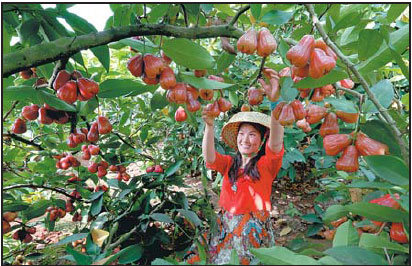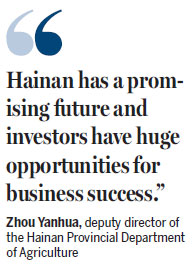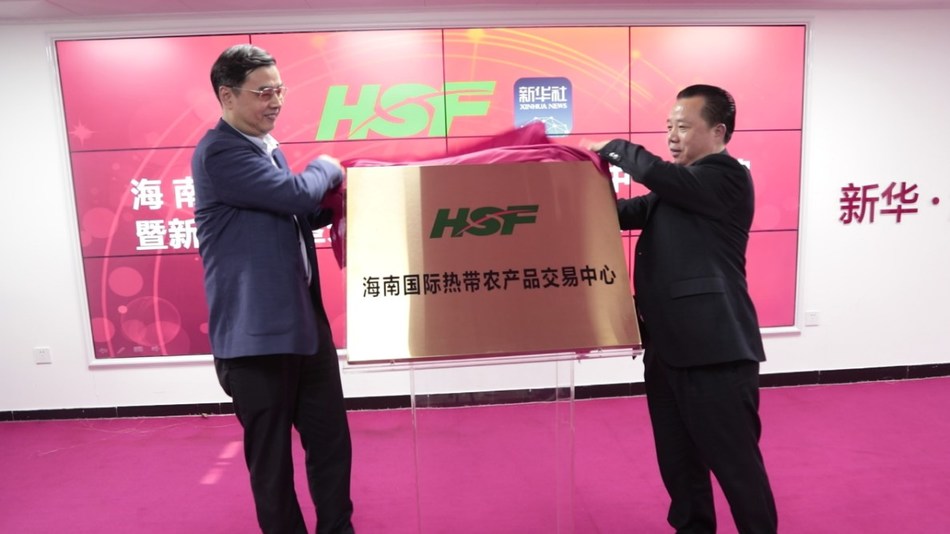
Hainan, China's only tropical island province, is boosting tropical agriculture as a pillar industry of its supply-side reform agenda during the 13th Five-Year Plan (2016-20) period, according to local officials.
Zhou Yanhua, deputy director of the Hainan Provincial Department of Agriculture, said with a tropical marine and monsoon climate that provides sufficient sunshine and rainfall, Hainan has unlimited potential to develop a unique agricultural industry.
The island has a beautiful natural environment, quality air and water, unpolluted soil and organic farms.
She said Hainan's green image offers significant market potential for its agricultural goods, because people care more about product quality these days.
As the country's largest special economic zone, Hainan enjoys flexible policies that have helped to develop an agricultural structure that highlights high-efficiency farming instead of grain production, Zhou said.
The province's efforts to build an international tourist destination, aiming to attract 80 million visitors per year by 2020, will also create huge demand for tropical farming products and leisure farming projects.
The local agriculture, forestry, animal husbandry and fishery businesses mainly include marine fishing, aquaculture, tropical fruits, the cultivation of winter vegetables, high-quality livestock and poultry breeding, rubber and coffee, as well as other tropical crops.
Growth in the agricultural industry is gaining new momentum thanks to new vigor generated in the industry by the National Tropical Agriculture International Exchange and Cooperation Center, 100 national modern agriculture parks, provincial-level modern farming demonstration bases, 30 internet agriculture towns, more than 4,000 e-commerce farm produce stores and 28 publicly listed companies.
The Ministry of Agriculture is also supporting Hainan in establishing itself as a demonstration province for ecological recycling agriculture.
The integration of agricultural businesses is accelerating and leisure agriculture village tourism is becoming an important attraction for all-encompassing tourism, according to Zhou.
"As a step taken to upgrade the province's agriculture structure, we have prepared a large number of projects for investors to consider at the 2017 Hainan Comprehensive Investment Fair to be held next week in Haikou. The sectors include planting, aquaculture, processing, leisure farming and e-commerce for farm products," said Zhou.
Hainan is striving to introduce more social funds from home and abroad to promote integration across the agricultural industry, enhance its international competitiveness and help build a beautiful new Hainan.
"As the country is entering a new period of promoting agricultural supply-side structural reform, Hainan has a promising future and investors have huge opportunities for business success," said Zhou.
Natural conditions and development efforts in recent years have laid a solid foundation for Hainan's further development, according to officials. Over the past five years, the agricultural industry's added-value growth has remained higher than 5 percent annually, according to official statistics.
Officials from the provincial agricultural authorities said Hainan is busy building a number of new production bases to boost the quality and efficiency of farming products.
The National Tropical Modern Agricultural Base is driving this change. The organization includes a national winter vegetable base, a tropical fruit base, a winter crop breeding and reproduction base, a tropical plants base, an ocean fishing base and an animal disease-free zone.
By Ma Zhiping ( China Daily )


